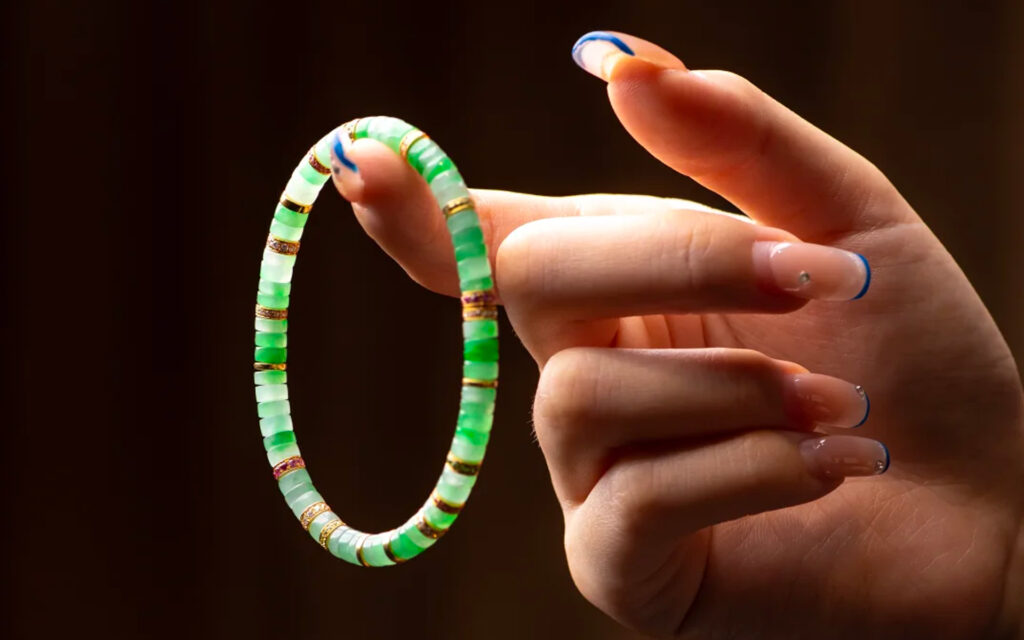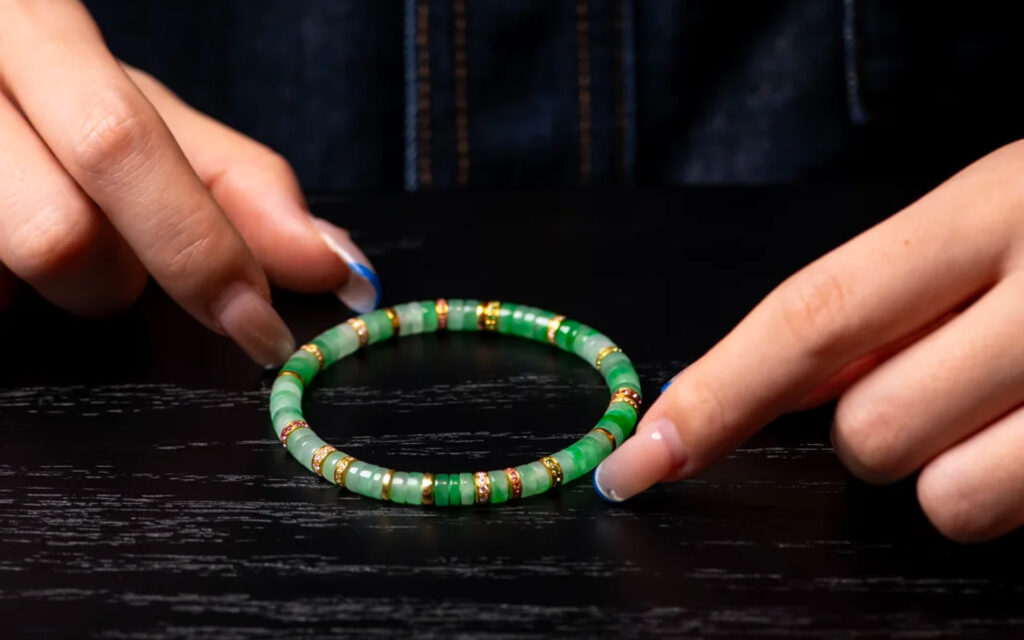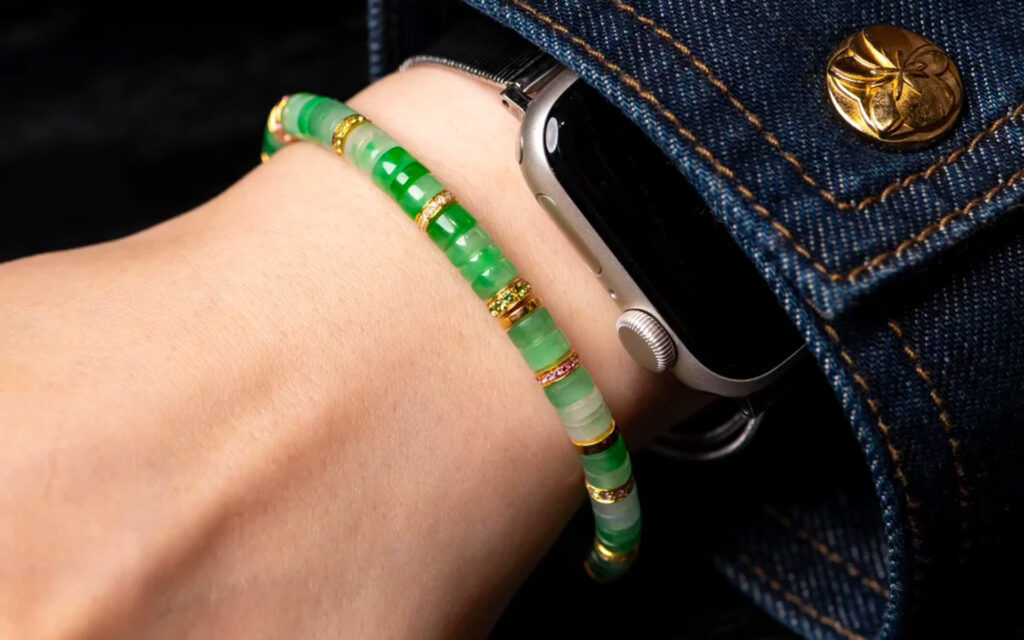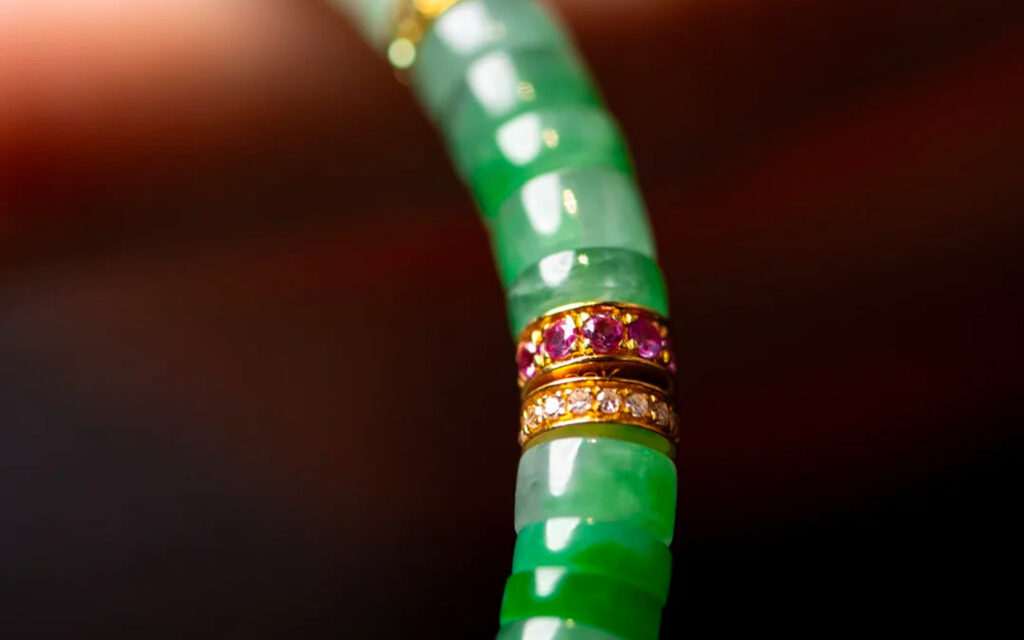As a treasure of Eastern jewelry culture, jadeite bracelets are highly prized for their decorative appeal and collectible value. However, the market is flooded with counterfeits such as B-grade jadeite (acid-washed and resin-filled), C-grade jadeite (dyed), Malaysian jade, and water-mist jadeite, making accurate authentication a major challenge for consumers. Below, we systematically outline core methods for authenticating jadeite bracelets, combining standards from jewelry appraisal institutions with folk wisdom.

I. Basic Visual Inspection: Authentication Clues Visible to the Naked Eye
1. Decoding Color Characteristics
Natural Gradation: Genuine jade exhibits gradual color transitions, such as shifting from seedling green to oil-green hues, with color roots (darkest areas) diffusing in thread-like patterns. Dyed jade displays flat, uniform colors—e.g., Malaysian jade shows consistent vivid green without transitional edges.
Fluorescence Response: Under UV light, B-grade jadeite exhibits strong blue-white fluorescence due to epoxy resin filling, while natural jadeite shows only weak, localized fluorescence.
2. Structural Feature Analysis
Jadeite Texture: Transillumination reveals needle-like or flaky flashes (mineral cleavage planes), colloquially known as “fly wings.” B-grade jadeite loses its “fly wings” due to acid-washing structural damage, revealing a net-like acid-etched pattern on the surface.
Cotton-like inclusions: Natural jadeite contains inherent cotton-like inclusions and stone patterns, such as snowflake-like inclusions in ice-type jadeite, whereas B-grade jadeite exhibits a hazy, cloudy appearance due to colloidal filling.
3. Luster and Transparency
Glassy Luster: Natural jade exhibits a sharp, glassy luster. B-grade jade develops a waxy luster as the resin ages, while C-grade jade appears dull due to dye deposition.
Translucency Test: Under strong flashlight illumination, natural jade shows uniform light transmission revealing interwoven fiber structures; dyed jade displays concentrated color bands along fractures.

II. Physical Property Testing: Scientific Authentication
1. Density Testing Methods
Weight Test: Jadeite density ranges from 3.30–3.36 g/cm³. Bracelets should feel distinctly heavy in hand. Imitations like glass (2.5 g/cm³) or resin (1.1–1.2 g/cm³) feel noticeably light.
Saltwater Test: Submerge the bracelet in a 1:4 saltwater solution (density approx. 1.25 g/cm³). Natural jade sinks slowly, resin imitations float, and glass imitations sink rapidly.
2. Hardness Testing
Scratch Test: Gently scrape the surface with a sharp knife. Natural jade (Mohs hardness 6.5–7) shows no scratches, while glass (5.5) and resin (2-3) will show visible marks.
Glass Scratch Test: Natural jade can scratch glass surfaces without damaging itself. Exercise caution during this test to avoid damaging the bracelet.
3. Acoustic Properties
Tapping Test: Hold the bracelet in the air and lightly tap it with a hardwood stick. Natural jade produces a clear, metallic ringing sound. B-grade jade emits a dull, stone-like sound, while resin imitations produce a muffled sound.

III. Professional Instrumental Analysis: Authoritative Certification Assurance
1. Infrared Spectroscopy
Detects the presence of epoxy resin (indicative of B-grade jadeite) and organic dyes (indicative of C-grade jadeite) with over 99% accuracy.
2. Refractive Index Measurement
Natural jadeite exhibits a refractive index of 1.66 (point measurement method). B-grade jadeite shows a reduced refractive index below 1.65 due to resin filling, while Malay jade (dyed quartzite) has a refractive index of 1.54.
3. Raman Spectroscopy
Identifies jadeite’s mineral composition. Natural jadeite primarily consists of jadeite; B-grade exhibits characteristic epoxy resin peaks; water-mist jade (sodium feldspar jade) displays specific spectral bands.
IV. Dual Verification: Certificates & Channel Authentication
1. Appraisal Certificate Verification
Requires merchants to provide CMA, CAL, or CNAS-certified testing certificates. Key verification points:
Total mass (accurate to 0.01g)
Refractive index (1.66±0.02)
Infrared spectrum (displaying natural jadeite characteristic peaks)
Whether “treated” (B-grade, C-grade) is noted in remarks
2. Purchase Channel Selection
Prioritize: Jewelry and Gemstone Quality Supervision and Inspection Center-certified merchants, established brand boutiques, e-commerce platforms supporting re-inspection.
Avoid: Tourist stall vendors, “bargain hunting” livestreams, or low-priced promotions without certificates.

V. Practical Case Analysis: Pitfall Avoidance Guide
Case 1: Dyed Quartzite Imitating Ice-Type Jadeite
Characteristics: Excessively vivid and uniform color; visible thread-like color roots when held to light; unusually light weight; refractive index 1.54 (significantly lower than jadeite).
Countermeasure: Request certification from the seller and inspect for fluorescence under a UV light.
Case 2: Glass Imitation Imperial Green Jadeite
Characteristics: Dull, plastic-like color; internal bubbles; dull sound when tapped; leaves scratches when scraped against glass.
Countermeasure: Inspect surface for acid etching marks with a magnifying glass and conduct a saltwater test.
Case 3: B+C Composite-Treated Jadeite
Characteristics: Exhibits both acid-washed mesh patterns and dyed color bands; strong fluorescence under UV light; abnormal density (due to structural loosening from multiple treatments).
Countermeasure: Submit to professional institutions for infrared spectroscopy analysis; reject “high-priced items without certificates.”
Jadeite authentication requires a triple verification approach of “observation-testing-certification.” Avoid relying solely on “eye-based judgment” or single methods. Beginners should follow the “look more, buy less” principle, gradually acquiring pieces after gaining experience. Remember: A jadeite’s true collectible value stems from its natural attributes and craftsmanship, not merely the pursuit of “flawless perfection.” Mastering these appraisal techniques enables discerning eyes to identify genuine gems amidst the market’s dazzling array, safeguarding your jewelry investment.